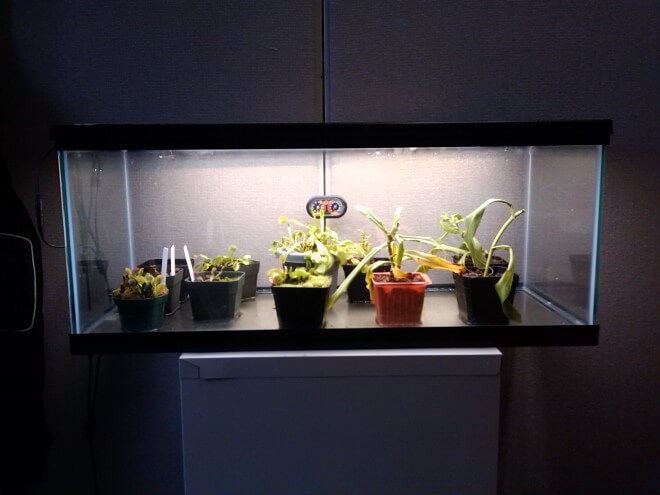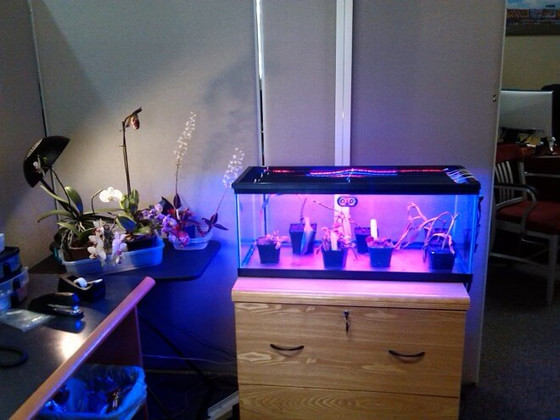
Growing Plants Indoors with LED Strip Lighting
10/03/16
Hello Friends, my name is Jeremy Feistner and I am a customer service representative here at Birddog Lighting in lovely Bozeman Montana. One of my favorite hobbies is growing Orchids and Carnivorous Plants. I have been involved in this hobby for over fifteen years and have done fairly well with the plants in my collection. I am super excited to work for Birddog Lighting and have the opportunity to experiment with using LED lights for growing plants indoors. I have always been an indoor grower using T-8 fluorescent shop lights with one warm bulb and one cool bulb in each fixture to supplement the spectrum of light that plants need to grow and bloom. I want to take a minute or two and cover some of the basics about what plants are looking for when it comes to light as well as a couple of my projects that I’ve recently upgraded to using daylight LED bulbs for plants. First, it is important to remember, plants use only two parts of the spectrum of light. The visible spectrum is a narrow band of the electromagnetic spectrum which encompasses light that is visible to the human eye. Visible light is classified by wavelengths, which are a unit of measurement expressed in nanometers (nm) – a nanometer is 1 billionth of a meter. Plants use the blue and red wavelengths of the visible spectrum, 440 nm in blue and 620 nm in red are seen to be optimal wavelengths for plants to absorb light. Second, the intensity of light, expressed in lumens (lm), is another consideration when growing your plants indoors and many varieties of plants will be different in the intensity of light they need, including some plants that are in the same family. Always do a little research to see what your specific plants need so that you can provide for them adequately. Lastly, white light is measured in degrees Kelvin (K) to distinguish the color “temperature”. The lower the number in Kelvin temperature (degrees) the warmer the light will appear to the eye. On this temperature scale the warm colors of white light: reds, oranges, and yellows are on the low end – 1,000 to 3,500K, with the cooler colors: cyan, and blue, are on the high end 5,500 – 7,000K. There is also a neutral segment between the warm and cool color temps called “natural” or “daylight” white, typically these color temps range from around 4,000 to 5,000K. The two types of white light for plant growth are warm white – 3,000K range and cool white – 6,000K range. The degree of Kelvin temperature does vary, and everyone has a different opinion about what works best. So, try and remember that these are only starting points and you will be able to adjust to what is available and what works for you. Previously in my indoor grows I’ve used fluorescent T8 shop lights with one warm color temperature bulb and one cool color temperature bulb in each fixture to supplement the spectrum of light that plants need to grow and bloom. But, recently I converted my T-8 fluorescent shop lights over to LED from our stock here at Birddog Lighting You can find the bulbs I used in that project here at this link. https://www.birddogdistributing.com/led-t8-tube-lights/. When I changed the fixtures I had to remove the ballast and connect the wiring back together for the LED T8 bulbs to work. Birddog now has LED T8 bulbs that do not require removing the ballast so it makes it even easier. I used one warm white bulb, at 3800K, along with one cool white bulb, at 5500K, in each fixture and have a total of four fixtures in a 4x3x6-foot space. I have two fixtures that are attached to my ceiling and hang above my plants on the top shelf of a bench. I have the other two fixtures attached to the underneath of the shelf to light plants on a lower shelf. The difference in just the visibility of seeing my plants has been amazing! The light in a fluorescent tube generally is emitted mainly from the center of the bulb and emitted in 360 degrees, so much of the light output is either completely wasted by shining light in the wrong direction, or diminished by having to be reflected off of the fixture. Conversely, LED’s produce a consistent even light all the way across the bulb and only emit light on the bottom half of the tube facing the area that needs it, meaning none of the light produced is wasted at all. This lighting appears to be making my plants at home very happy! My other project with Venus’s Fly Trap (VFT) plants require a lot of light especially since I am growing them indoors. I did some research on our 12v strip lights here at Birddog Lighting to see what I could come up with for my VFT’s. I also want high humidity with my VFT’s so I decided that I would keep them in terrariums that are 1x1x2.5 feet. I started looking at this link on our website, https://www.birddogdistributing.com/cool-white-led-strip-light-12-volt-high-output-smd-5050-indoor-use-ip22-16-4-feet/ and tried to figure out what exactly my plants would need for light: cool white, warm white, red, or blue. To find the best solution I decided to experiment and have red and blue LED strip lights in one tank and warm white and cool white strip lights in the other. My goal is to see which combination of lighting in each tank produces the best plant reactions. I scrolled down the page and checked the specifications to see if our LED’s had the spectrum of light that I was looking for and sure enough, they Do! Red has the nm wavelength that is suggested at 625-630 and blue is at 465-470 nm. Our warm white strip light comes in 2900-3200k which is right where I want to be and cool white is 5500-6000k. Again, right where I want it to be! Now I had to look at the intensity of the light because these plants really like as much light as they can get when it is artificial lighting. The Lumen output (lm) per LED is 16lm and I wanted to achieve at least 2400lm per foot of growing area. I have 2.5 square feet of growing room within the tank area so I am looking for approximately 5,000lm in the tank. There are 3 LED’s in every two-inches of strip light and I used 26” runs in the tank so that equals 39 LED’s per run and 624 lm. I decided to go with 4 runs of red and 4 runs of blue in one tank, with 4 runs of warm white and 4 runs of cool white in the other. If my calculations are correct, I am getting approximately 4,992lm in each tank! I attached the strip lighting under the cover of reptile lids so that there would be plenty of air movement and used Velcro in order to let me change the lights out easily. So far the Velcro attachment hasn’t worked as well as I had hoped so I need some adjustments. I will continue to update the website and let everyone know how things are going and if anyone has any questions please feel free to give me a call at 406-586-5970 and I will help you to the best of my ability! 


